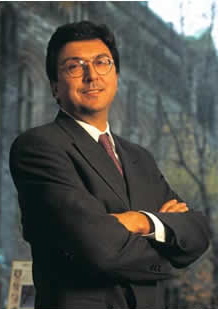A few weeks ago, I stopped by the new dome at Varsity Centre and was amazed at the beehive of activity I found there. An intramural soccer game was underway on half the field, while students, alumni and members of the intercollegiate golf team busily hit balls on the other half. Several students were playing Frisbee along the sidelines. It was a wonderful snapshot of how great new spaces can enhance student life.
It may not be immediately apparent to outside observers, but a quiet revolution is underway at U of T. Countless faculty members and staff are focused as never before on transforming the way students experience the university, both inside and outside the classroom.
For years, U of T has faced a number of challenges due to the size and makeup of its student population. Most undergraduates don’t live on campus. And a recent survey on student engagement found that even though U of T has more than 300 student clubs and the largest varsity and intramural sports program in Canada, 60 per cent of commuter students spend zero hours a week in extracurricular activities. As always, the money to solve this problem is in short supply: Ontario remains last among the provinces in per capita funding of higher education, a position it has occupied for many years.
U of T has long addressed these challenges with an arsenal of not-so-secret weapons. The college system on the St. George campus divides a large student community into smaller neighbourhoods. Our professors are outstanding, and we offer a tremendous choice of programs and courses, including a substantial number of small classes in the upper years of any baccalaureate program. We also offer students the chance to learn abroad at more than a hundred universities around the world.
Recently, however, we’ve been improving the student experience with other initiatives. We are re-engineering the undergraduate academic experience by extending the opportunity to join First-Year Learning Communities to 650 students in the Faculty of Arts and Science (almost triple the number of two years ago). These small groups of students meet regularly outside of class with a senior student and a staff member, providing new students with a way to meet their classmates and learn about the university in a casual setting.
We’re improving the quality of the spaces available to students for academic purposes. New facilities include the Leslie L. Dan Pharmacy Building, the Arts and Administration building at U of T Scarborough and the Hazel McCallion Academic Learning Centre at U of T Mississauga. And we now offer wireless internet access at 900 separate points across all three campuses. We’re also expanding the quality and quantity of places that enhance life outside the classroom. The Recreation, Athletic and Wellness Centre at U of T Mississauga, the Varsity Centre and the new baseball field at U of T Scarborough add some much-needed capacity to our athletic facilities. And the new Multifaith Centre in the Koffler Institute on Spadina Avenue offers students a place to express their spirituality.
We’re using new electronic resources to build communities and participation. Students will be able to use a new customized portal and can now access ULife www.ulife.utoronto.ca, a resource that brings together more than 1,000 listings of extracurricular activities at U of T in a neat, user-friendly database. Students looking to get involved in filmmaking, debating, sports, social activism, charities – almost anything they can think of – will find a way to do so through ULife.
I could list more initiatives. We need lots of them, because U of T is a big place and change comes slowly. What matters, however, is that there is now clear momentum in the right direction.
That momentum is overdue. Time after time, when I meet with students, I hear two views of the University of Toronto. One, incredibly positive, I hear from students who are involved in extracurricular activities or from those who have found courses and professors that are transforming the way they see the world. The other view comes from students who simply can’t find their “comfort zone” inside or outside the classroom; this view is still too prevalent. A few years from now, we hope the vast majority of our students will look back on their time at U of T as a transformative period of learning, personal growth, and positive experiences. That’s how many of us remember it, and we owe this generation nothing less.
Recent Posts
U of T’s 197th Birthday Quiz
Test your knowledge of all things U of T in honour of the university’s 197th anniversary on March 15!
Are Cold Plunges Good for You?
Research suggests they are, in three ways
Work Has Changed. So Have the Qualities of Good Leadership
Rapid shifts in everything from technology to employee expectations are pressuring leaders to constantly adapt






